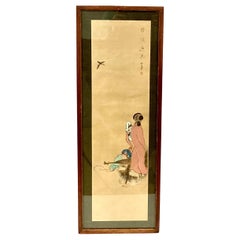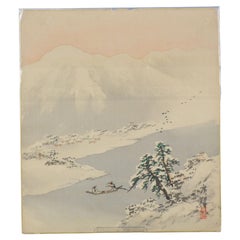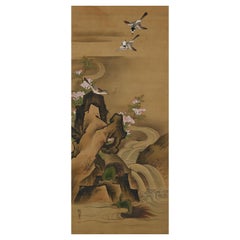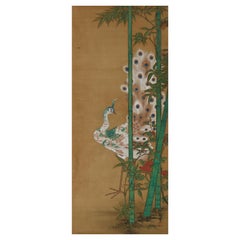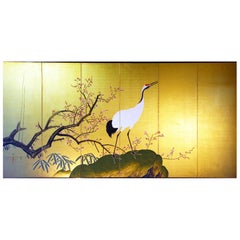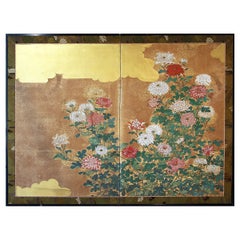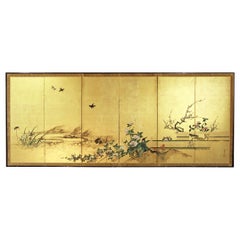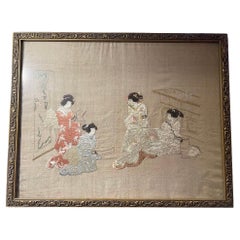Japanese Silk Paintings
20th Century Japanese Anglo-Japanese Paintings and Screens
Silk, Wood, Paint
Antique 19th Century Chinese Edo Paintings and Screens
Bronze
Antique Mid-19th Century Asian Edo Paintings and Screens
Silk
Antique Mid-19th Century Asian Edo Paintings and Screens
Silk
Antique Mid-19th Century Asian Edo Paintings and Screens
Silk
Antique Late 19th Century Japanese Meiji Paintings and Screens
Gold Leaf
Antique Late 19th Century Japanese Meiji Paintings and Screens
Gold Leaf
Antique Early 19th Century Japanese Edo Paintings and Screens
Gold Leaf
Mid-20th Century Japanese Paintings and Screens
Silk
Antique 1840s Japanese Edo Paintings and Screens
Silk
Early 20th Century Japanese Showa Paintings and Screens
Silk
20th Century Japanese Paintings and Screens
Silk, Wood
Antique 19th Century Japanese Japonisme Paintings and Screens
Silk, Paper
Antique Late 19th Century Japanese Paintings and Screens
Silk
Antique 19th Century Japanese Paintings and Screens
Silk
Vintage 1910s Japanese Taisho Paintings and Screens
Wood, Silk
Antique 19th Century Japanese Paintings and Screens
Silk
Antique 19th Century Japanese Edo Paintings and Screens
Metallic Thread
20th Century Japanese Paintings and Screens
Silk
Antique 19th Century Japanese Meiji Paintings and Screens
Silk, Wood
Antique Early 1900s Japanese Paintings and Screens
Brocade, Silk, Paper
20th Century Japanese Showa Paintings and Screens
Silk, Plexiglass, Paper, Wood
Antique 19th Century Japanese Edo Paintings and Screens
Silk, Paper
Antique Mid-19th Century Japanese Meiji Paintings and Screens
Silk
Mid-20th Century Japanese Paintings and Screens
Silk
21st Century and Contemporary Japanese Paintings and Screens
Silk
20th Century Japanese Taisho Paintings and Screens
Silk
Mid-20th Century Japanese Paintings and Screens
Silk, Paint
20th Century Japanese Showa Paintings and Screens
Silk, Paper
21st Century and Contemporary Japanese Meiji Paintings and Screens
Brocade, Silk
Antique Mid-19th Century Japanese Meiji Paintings and Screens
Silk
Antique 18th Century Japanese Edo Paintings and Screens
Silk, Paper
Antique Late 19th Century Japanese Meiji Paintings and Screens
Silk, Wood
Antique Late 19th Century Japanese Japonisme Paintings and Screens
Silk, Bamboo
20th Century Asian Paintings and Screens
Silk
21st Century and Contemporary Japanese Meiji Paintings and Screens
Silk, Brocade
Antique 19th Century Japanese Paintings and Screens
Silk
Antique 19th Century Japanese Meiji Paintings and Screens
Silk
Vintage 1970s Japanese Edo Paintings and Screens
Silk, Wood
Antique Mid-19th Century Japanese Meiji Paintings and Screens
Silk
Antique Mid-19th Century Japanese Meiji Paintings and Screens
Silk
Antique Mid-19th Century Japanese Meiji Paintings and Screens
Silk
21st Century and Contemporary Japanese Meiji Paintings and Screens
Brocade, Silk
Antique 1880s Japanese Paintings and Screens
Early 20th Century Japanese Taisho Paintings and Screens
Silk
20th Century Japanese Showa Paintings and Screens
Brass
Early 20th Century Japanese Meiji Paintings and Screens
Silk
Antique Late 19th Century Japanese Late Victorian Paintings and Screens
Silk
20th Century Japanese Paintings and Screens
Silk, Paper
Vintage 1920s Japanese Japonisme Paintings and Screens
Silk
Antique 1880s Japanese Meiji Paintings and Screens
Silk
Antique 19th Century Japanese Paintings and Screens
Silk, Paper
Antique 19th Century Japanese Paintings and Screens
Silk
20th Century Japanese Mid-Century Modern Paintings and Screens
Silk, Wood, Paper
Antique 19th Century Japanese Paintings and Screens
Silk
21st Century and Contemporary Japanese Meiji Paintings and Screens
Brocade, Silk
Antique 19th Century Japanese Paintings and Screens
Silk, Paper
21st Century and Contemporary Japanese Meiji Paintings and Screens
Gold
21st Century and Contemporary Japanese Meiji Paintings and Screens
Brocade, Silk
Early 20th Century Japanese Paintings and Screens
Brocade, Silk
- 1
- ...
Japanese Silk Paintings For Sale on 1stDibs
How Much are Japanese Silk Paintings?
Finding the Right Paintings And Screens for You
Traditional Asian paintings were often created on scrolls and folding screens. Artisans made screens that could be folded up or spread out by connecting several panels using hinges. Today, antique Asian folding screens and paintings are sophisticated decorative accents that can serve as makeshift partitions to ensure privacy.
The original folding screens were created by Chinese artists. The earliest record of screens comes from the 2nd century B.C., and surviving examples date back to the Ming dynasty. Chinese painting utilizes many of the same tools as calligraphy — these screens were crafted from wood with painted panels featuring striking art or calligraphy that told cultural stories or represented nature and life in the area.
The practice was introduced to Japan, where paintings for screens were made on paper and silk, in the 8th century. These paintings frequently feature subjects such as landscapes, animals, flowers and Buddhist religious themes. Along with screens for tea ceremonies and dance backgrounds, there were screens for use in Shinto and Buddhist temples.
In the 17th century, screens began to be imported to Europe where their popularity grew. Coco Chanel famously collected Coromandel folding screens.
Traditional Asian paintings can make a tasteful addition to any wall, and screens can be used as decoration or, in the case of larger iterations, as an aesthetic way to divide a large room. Browse the selection of antique Asian paintings and screens from a variety of styles and eras on 1stDibs.
- 1stDibs ExpertMarch 22, 2022Japanese paintings have many names, based on their style. Works produced after 1900 are known as Nihonga and combine traditional techniques with modern themes. Sumi-e are traditional Japanese ink paintings, while Ukiyo-e are figure and landscape paintings from the 17th to 19th centuries. On 1stDibs, find a range of Japanese art.
- What is silk painting called?1 Answer1stDibs ExpertApril 5, 2022What silk painting is called depends on the origins of the artwork. In Tibet, silk paintings made for religious rituals are thangka, while in Vietnam, the traditional art form is known as tranh lụa. On 1stDibs, shop a range of silk paintings.
- 1stDibs ExpertApril 5, 2022A Japanese silk painting is identifiable by its depictions of everyday life and scenes that are abundant with detail. The red seal or chop can also help you determine the artist of the piece. You can shop a collection of expertly vetted Japanese silk paintings from some of the world’s top sellers on 1stDibs.
- 1stDibs ExpertApril 5, 2022A Japanese silk robe is also known as a kimono, sometimes also called a wafuku or a gofuku. Traditionally these brilliantly colored robes are actually layered dresses that fold across the front and are held together with a cloth belt called an obi. On 1stDibs, find vintage and contemporary kimonos from top sellers around the world.
- 1stDibs ExpertApril 5, 2022Japanese painting is called “nihonga”. This style of painting is characterized by a reduced color palette, a lack of shadows and simple expression. Works in this style are often created with mineral-based paints on scrolls and screens and depict landscapers, women and scenes from Japanese history and culture. You’ll find a wide range of nihonga art on 1stDibs.
- 1stDibs ExpertApril 5, 2022Japanese screen painting is the art of creating byōbu, or Japanese screens. Byōbu vary in subject matter and style. The screens are free-standing, portable and decorated with symbolic images or calligraphy. It is common to find byōbu in pairs with at least two panels. Shop a selection of byōbu on 1stDibs.
Read More
Chicago’s Pagoda Red Has a Spirited Mix of Asian Antiques and Bold New Art
For 25 years, gallerist Betsy Nathan has leveraged her keen eye and key connections to bring a unique selection of rare finds to the market.
In L.A., Gallerist JF Chen Has Long Championed Eclectic Blue-Chip Design
Now working alongside his daughter Bianca, dealer Joel Chen has presented a most covetable array of antiques, art and contemporary creations for more than 40 years.
12 Calming Spaces Inspired by Japanese Design
From cherry-blossom-adorned walls paired with glamorous lighting to wood-paneled ceilings above checkerboard-patterned chairs, these 12 spaces seamlessly blend Eastern and Western aesthetics.
Rodrigo Rivero Lake’s Mexico City Showroom Is a Museum-Worthy Trove of Spanish Colonial and Asian Antiques
The dealer and curator has spent the past 50 years amassing a collection of exceptional art, furniture and architectural elements that trace the cultural influence of the Spanish empire from Europe to the Americas and beyond.
16 Refined Asian-Inspired Interiors
These spaces exemplify how Eastern elements elevate a home's decor.
